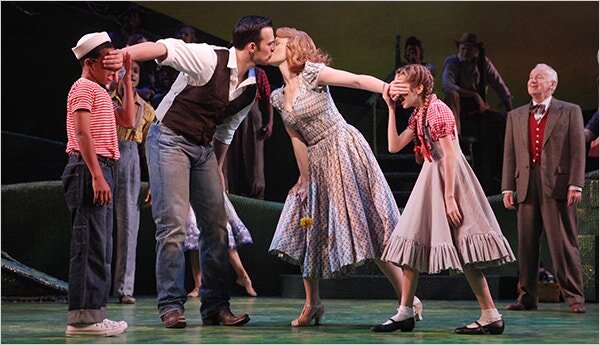Finian's Rainbow
It’s hard not to think too much nowadays. When someone says, “Don’t worry,” the impulse can be to laugh. With the economy sinking, unemployment rising, screaming pundits on TV and winter just around the corner, one’s mind can always be racing with worries or concerns.
Thankfully, there is one place in New York where it is easy not to think; one haven where people can turn off their minds and instead enjoy thoughts of beauty, love and – dare I say it? – hope for the future. This place is the St. James Theater, where the robust revival of Finian’s Rainbow, currently in performances.
The plot of Finian’s Rainbow is one that, thankfully, does not require much thought. In fact, it is more easily enjoyed and appreciated it one doesn’t think about it too much. First performed in 1947, it was considered by many to be too corny, too oddball or even just too cheerful for another successful Broadway run, but this unlikely candidate, which features a refreshingly satirical way of looking at issues like race, class, money and even love, has turned out to be just what the doctor ordered for the exhausted, overworked, unemployed masses of New York.
It is not the plot which drives this spellbinding production of Finian’s Rainbow, but the music, performed by this talented, enthusiastic cast, which features the mesmerizing Kate Baldwin as Sharon, Cheyenne Jackson as Woody, Christopher Fitzgerald as Og, and Chuck Cooper as a prejudiced Senator who was white and is magically turned black (more on that later).
The story of Finian revolves around the title character and his daughter, who move from Ireland to the state of Missitucky in search of fortune. Armed with a pot of gold stolen from a leprechaun in their native country, they intend to plant it in the ground and reap fortune from the soil. This plan only seems more appealing when the spunky Sharon meets the strapping Woody and they quickly fall in love. However, Finian’s plans change slightly when they learn that the leprechaun Og (the superb Christopher Fitzgerald) has followed them to Missitucky to retrieve his gold before he is transformed into a human. (This transformation is depicted by the periodic shortening of Mr. Fitzgerald’s pants, which reach dangerous heights before the show has ended).
The more serious, and more sarcastic, aspects of the plot include a racist Senator (David Schramm) who, along with some corrupt counterparts, is determined to trick the group of tobacco farmers that Sharon and Finian have befriended out of the land they live and work on. After the Senator expresses his contempt for the black residents, Sharon impulsively wishes that the Senator was black himself so he could know what it was like. What she didn’t expect was for her wish to be granted and for the Senator to actually turn black (and played by Chuck Cooper).
Economic woes, foreclosure and racism are just some of the themes of this show that are all too relevant to today’s audience, and they could have a depressing effect if they were delivered in a less melodic way, by a less talented cast. Kate Baldwin is luminous as Sharon, a feisty, spirited Irish lass with a clear, haunting soprano. Her performance of one of the show’s most famous songs, “How Are Things in Glocca Morra?” is especially moving. She shares excellent romantic chemistry with Jackson, who has firmly established himself as one of Broadway’s most valuable leading men, and the love duets sung by this twosome are more than likely to elicit a sigh or two from soft-hearted audience members. Jim Norton’s performance as Finian is worthy of approval from any native Irishmen or women, and Alina Faye is first-rate as Susan the Silent, a mute who can only communicate through dance. Chuck Cooper’s performance as the Senator is also excellent, especially when he meets three gospel singers looking for a fourth member of their quartet. Their performance of the song “The Begat” is truly superb (especially when they sneak in a line about “the misbegotten GOP”).
It is Christopher Fitzgerald who commits the greatest act of thievery in recent Broadway history, stealing every scene he is in, even without speaking. Having enjoyed him thoroughly as Igor in Young Frankenstein I was eager to see him back onstage and this talented comedian more than exceeded my expectations. As a leprechaun slowly losing his magical abilities and learning the joys and woes of being human, Fitzgerald brings warmth and compassion to his performance as well as almost frightening levels of hilarity. He sings, he dances, he juggles and he manages to pull of wearing very short shorts, all while eliciting laugh after laugh with a performance that is still restrained and professional.
Finian’s Rainbow is clearly a mystical story, and the set and costumes reflect this easily. John Lee Beatty’s sets are bright and bold and not at all realistic, and the costumes can be described the same way, which are well suited for the athletic, twirling choreography by director Warren Carlyle, which are executed with so much energy and joy that they also appear to be from another world.I left Finian’s Rainbow with a smile on my face without a worry on my mind, which is more than I can say about many other performances I have seen recently. If you think about it too much, you won’t enjoy it. So don’t think, and just watch.

